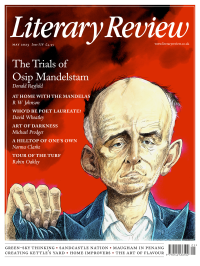Tim Blanning
Emperors, Mystics & Tomcats
The Middle Kingdoms: A New History of Central Europe
By Martyn Rady
Allen Lane 640pp £35
‘But where is it? I don’t know how to find it.’ Friedrich Schiller was asking about the location of Germany, though he might just as well have been asking about ‘Central Europe’. In the further reading section at the end of this book, Martyn Rady points out that there are innumerable national histories of different countries, but almost none dealing with his chosen subject as a whole. The best he can come up with are two books on ‘East Central Europe’, and both of those are confined to specific periods – one to the Middle Ages, the other to the interwar years. He is certainly aware of the problem, candidly allowing that Central Europe can be ‘characterized by what it is not’ and that ‘political boundaries change, and with every alteration the idea of Central Europe changed too’.
The boundaries used here are certainly fluid, changing shape constantly, like amoebae viewed through a microscope. Sometimes they spread all the way west to the North Sea, east to the Black Sea, north to the Baltic and south to the Adriatic. At other times they appear to shrink to embrace ‘only’ the Holy Roman Empire and the Habsburg monarchy. But if Frisia and Transylvania ‘could not be much further apart or physically more different’, what is the common denominator? It is a question that is not – and cannot be – answered satisfactorily. Although Rady does his best to persuade us that the Cheshire Cat is always present, he rather gives the game away by the insistent repetition of the phrases ‘Central European’ and ‘Central Europe’, as in ‘King Ernest Augustus was typical of Central European rulers’ or ‘rulers across Central Europe built palaces’, to pick two examples at random. A thoroughly nasty piece of work, King Ernest Augustus was, alas, typical of rulers well beyond Central Europe, however defined, and palaces were built everywhere.
Rady makes a gallant attempt in the conclusion to list the region’s unique characteristics, including the ubiquity of assemblies, the prevalence of empires and ‘the incongruity of state and nation’. Just listing these things, however, is a reminder that they were far from being unique to the region. The one

Sign Up to our newsletter
Receive free articles, highlights from the archive, news, details of prizes, and much more.@Lit_Review
Follow Literary Review on Twitter
Twitter Feed
The era of dollar dominance might be coming to an end. But if not the dollar, which currency will be the backbone of the global economic system?
@HowardJDavies weighs up the alternatives.
Howard Davies - Greenbacks Down, First Editions Up
Howard Davies: Greenbacks Down, First Editions Up - Our Dollar, Your Problem: An Insider’s View of Seven Turbulent...
literaryreview.co.uk
Johannes Gutenberg cut corners at every turn when putting together his bible. How, then, did his creation achieve such renown?
@JosephHone_ investigates.
Joseph Hone - Start the Presses!
Joseph Hone: Start the Presses! - Johannes Gutenberg: A Biography in Books by Eric Marshall White
literaryreview.co.uk
Convinced of her own brilliance, Gertrude Stein wished to be ‘as popular as Gilbert and Sullivan’ and laboured tirelessly to ensure that her celebrity would outlive her.
@sophieolive examines the real Stein.
Sophie Oliver - The Once & Future Genius
Sophie Oliver: The Once & Future Genius - Gertrude Stein: An Afterlife by Francesca Wade
literaryreview.co.uk